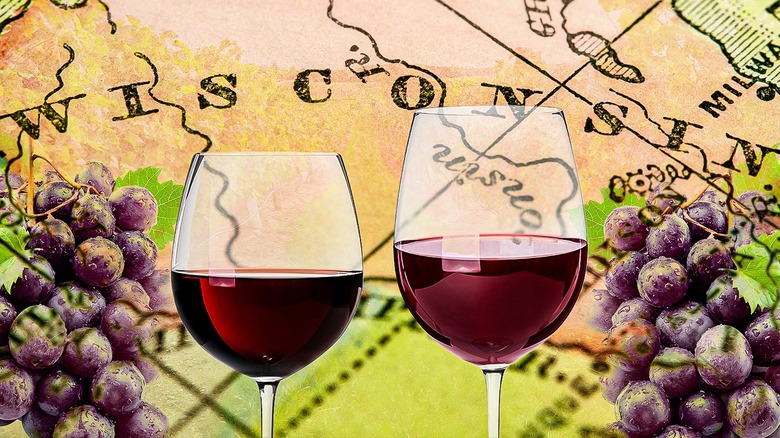Why Wisconsin Is Becoming The Next Hot Spot For Wine
The place where wine is made greatly impacts how it tastes and its overall character. This is known as "terroir" or the "sense of place." It's why wines from Bordeaux taste different from those made in California! But when it comes to great wine-making regions, a name you probably don't immediately think of is probably Wisconsin.
In recent years, however, the Badger State has started to make a name for itself in the wine world. This is driven by a combination of factors, but the most influential of which has to be environmental conditions. Traditional grape-growing regions like Naples and Bordeaux have struggled with climate change for a long time, with frost, dry periods, and diseases happening more frequently than ever. As these wine regions grapple with climate change, places that are less affected, like Wisconsin, have stepped up to the challenge.
Winemakers in the Wisconsin wine region have been growing grapes and making wine since the 1840s, a movement pioneered by a Hungarian-American nobleman named Agoston Haraszthy. Besides the ample access to water via the Wisconsin River, the soil condition and native climate are just right for growing tough, hybrid grape varieties like Marquette, Frontenac, and LaCrosse. Once sidelined in favor of red wines like Cabernet, Pinot Noir, and Merlot, they are now gaining prominence thanks to their adaptability to changing climates and diseases.
Second reason: the changing palete of wine drinkers
Wisconsin's growing popularity in the world of wine isn't solely due to its soil or climate. Another big factor is the changing demographics of wine enthusiasts. Younger people are getting on board, with 21% of wine drinkers in the U.S. falling in the 18 to 23 age range in 2023, as reported by Statista. These young enthusiasts have globetrotted and tasted wines from every corner of the world, experiencing a wide range of techniques and grape varieties. Consequently, they're more open to experimenting with various flavor profiles and nuances.
The shift in palate preferences and a growing appreciation for the unique characteristics of Wisconsin's wine have greatly benefited the industry. Nowadays, wine drinkers are more open than ever to trying distinctively flavored wines from Wisconsin and may discover that they enjoy them just as much as the familiar Italian Aglianico, Californian Cabernet, or French Chardonnay bottles.
Interestingly, Wisconsin wine hasn't been a longtime favorite in its home state. The grapes grown in Wisconsin tend to be more acidic due to the cold temperatures. However, many Wisconsinites may prefer preference for sweeter flavors, given the abundance of sweet apples and berries in the region's thousand-acre fruit orchards. To make their dry wines more appealing, winemakers have had to incorporate fruits to sweeten them artificially. Now that people are more willing to experiment, winemakers can let their creativity go wild and craft wines that truly reflect the terroir of the area!
What does Winconsinite wine taste like?
Wisconsin experiences colder winters compared to the traditional wine-growing regions of California, Bordeaux, and Naples, where temperatures can easily dip below freezing. Consequently, grapes grown in Wisconsin tend to be more acidic compared to other places with lots of sun. To offset this extra acidity, winemakers use various techniques to sweeten up the wine.
One such method is "sur lie aging," where the matured wine is left to continue aging on yeast cells. Over several months, the dead yeast would release more protein and sugar, enhancing the wine's complexity and balance, as well as giving it a distinct, creamy texture. A second approach is "back-sweetening," in which unfermented grape juice is added to dry wine. This results in a sweeter, more palatable wine right away without the winemaker having to wait several months for it to age sur lie.
However, despite these efforts to create a balanced wine, the pronounced acidity of grapes from cold climates remains a prominent characteristic of Wisconsinite wine, which will make it an exceptionally good pairing with savory, fatty dishes where its acidity can provide a lovely contrast to the food. However, if you prefer sweeter dessert wines such as Sauternes, Wisconsinite wine may taste a bit tarter than normal.


